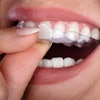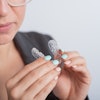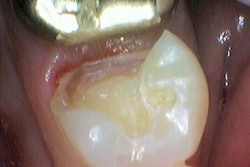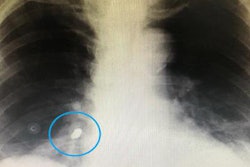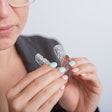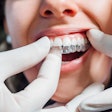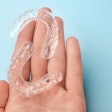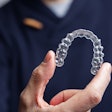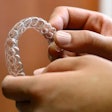
A fixed lower jaw dental retainer completely avulsed the canine tooth of a 26-year-old man in the U.K., according to a case report published June 24 in the American Journal of Orthodontics and Dentofacial Orthopedics. The tooth ended up requiring extraction.
Though teeth may move slightly when wearing a fixed retainer following orthodontic treatment, in this case the fixed retainer itself, which remained completely bonded to his teeth, produced the canine avulsion. Clinicians and patients should be aware of this rare but serious complication, noted author Dr. Parmjit Singh of the orthodontics department at the University of Ulster in Birmingham, U.K.
"A thorough investigation of any unwanted tooth movements occurring in the presence of a fixed retainer should be completed, and remedial action taken to prevent serious complications," Singh wrote.
Escalating problems for the patient
When the patient was about 16 years old, he had a fixed lower jaw retainer bonded to his six anterior teeth. He was also given removable retainers to wear on his upper and lower teeth. The man said his clinician told him to only wear the removable retainers for one year.
Several years later, the patient noticed his mandibular anterior teeth were moving, including his right lower jaw canine that had started to turn toward his lip. He raised these concerns with two different dentists, who found that the retainer was still attached to his teeth and reassured the patient that tooth movement may occur. Neither dentist performed any other treatment, according to the report.
Nine years after he had received the fixed retainer, the man noticed rapid, significant movement of his right canine. However, he delayed visiting a dentist due to the COVID-19 pandemic. For the next several months, the canine tooth turned completely on its side, but the man experienced no significant pain, Singh noted.
Then, at age 26, the patient went for a dental consultation. Though his maxillary arch was well aligned, his lower jaw right canine root had twisted 70° labially, leaving the apex completely exposed and revealing a shortened root apex. Additionally, his mandibular left lateral incisor root was exposed labially, nearly revealing the apex, and the mandibular left canine appeared with lingual root torque, Singh wrote.
To get a better view, the patient underwent x-rays, revealing generalized root resorption of 20% in most of his teeth and a maximum of 40% in the remaining upper jaw bicuspids and incisors. No alveolar socket for the patient's mandibular right canine was observed. A serial record was not possible because the records from the man's initial orthodontic treatment were unavailable, Singh acknowledged.
Clinicians treated the patient by pulling his canine tooth and removing his fixed retainer. They also warned the man that he may lose his left lower jaw lateral incisors.
For six months, clinicians monitored the patient for open bite relapse or torque differential improvements to the teeth that had been attached to the retainer. Due to root resorption and periodontal health, clinicians recommended no further extensive orthodontic treatment, Singh noted.
The possible cause
Using a fixed retainer bonded to all six anterior teeth is standard practice after orthodontic treatment. Complications can occur soon after fixed retainer placement, often due to the bonding technique and activation of the retention wire during placements.
When complications occur several years after placement, they likely are due to wire fatigue and mechanical deformation of the wire. Nevertheless, it is rare for patients to experience severe complications like in this case.
During a dental consultation, the clinician discovered that the multistrand retainer wire remained bonded to all six of his teeth, which indicated that an "untwisting action had almost certainly occurred," Singh wrote. Multistranded twisted retainer wires may cause tooth movement by untwisting, and as a result, create a twisting force between teeth.
In addition to long-term monitoring of fixed retainers, it is crucial that dentists and patients are aware of the complications associated with these orthodontic appliances, Singh wrote.
"It is likely that had the etiology of these unwanted tooth movements been identified earlier; the fixed retainer could have been removed and replaced and thus prevented tooth loss," he concluded.

